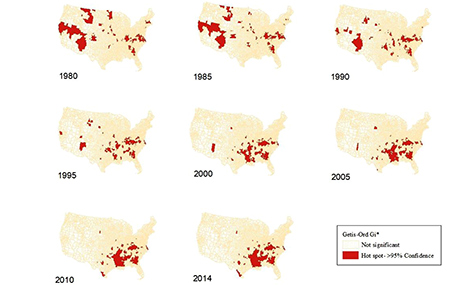 BW Public Health professors continue to mine historical data to find life-saving answers to questions about respiratory illnesses.
BW Public Health professors continue to mine historical data to find life-saving answers to questions about respiratory illnesses.
In the latest research published by a top-tier journal, Dr. Abolfazl Mollalo, with co-authors, Dr. Swagata Banik and Dr. Laura Hopkins, conducted pioneering work that predicts the location of hotspots of lower respiratory illness (LRI) in the United States.
For the first-of-its-kind study, published in the "International Journal of Medical Informatics," the BW researchers examined more than three decades of data on diseases of the lower respiratory tract, including bronchitis, bronchiolitis and pneumonia.
"Lower respiratory illnesses (LRI) have been classified as the seventh leading cause of death in the U.S., taking years off of life expectancy," explains Mollalo. "While several studies have been conducted in smaller geographic regions, no previous study examined geographic variations of LRI mortality rates and underlying factors across the U.S."
 For the BW study, Mollalo analyzed nationwide historical LRI data from 1980 to 2014 in association with 46 climatic, topographic, socio-economic and demographic variables.
For the BW study, Mollalo analyzed nationwide historical LRI data from 1980 to 2014 in association with 46 climatic, topographic, socio-economic and demographic variables.
Using novel methods, such as spatial statistics and machine learning techniques in a geographic information system (GIS) framework, the research has the potential to identify highly affected counties and to uncover possible reasons why lower respiratory mortality rates are higher in these areas.
"Predicting why the U.S. counties with high LRI mortality rates cluster geographically can be helpful to further reduce mortality in these regions," Mollalo says. "Despite significant efforts for control, there are many clustered counties, particularly in Georgia, Kentucky and Virginia, where LRI mortality rates have remained elevated for the past 35 years."
"Overall, there was a historical shift in hotspots away from the western U.S. into the southeastern parts of the country, and hotspots were highly localized in a few counties," Mollalo adds. "Environmental factors contributed most strongly to these hotspots, while economic and social factors seem to be of secondary significance."
Higher spring temperatures and increased precipitation during winter are among the most substantial predictors of the presence or absence of the hotspots.
The findings imply that future budget and resources, such as vaccine allocation and additional healthcare workers, should be a priority for these areas.